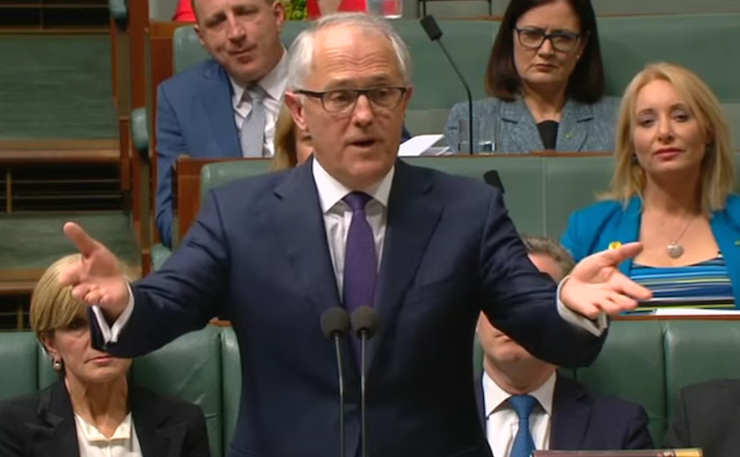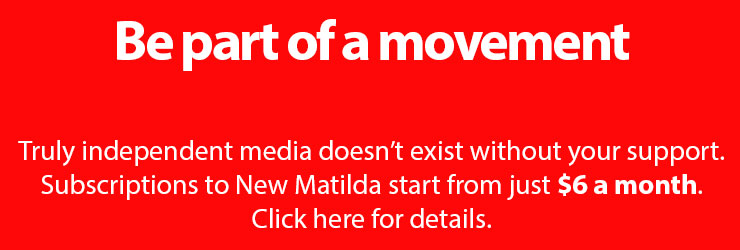The economy is looking steady for now but there’s good reason to think voters are actually worse off than they appear to be. Turnbull may be thinking it’s best to call an election before Australian politics starts to look more like the US, writes Ian McAuley.
The general interpretation of Turnbull’s political manoeuvres is that a double-dissolution election with the new electoral laws should rid the Senate of members of “shrapnel parties” holding the balance of power. He doesn’t want them hanging around until the next half Senate election in 2019.
The ostensible reason for his strategy – that the stalled industrial relations bills are crucial to the Government’s policy agenda – is unconvincing. They are nowhere near as important to the Coalition as Whitlam’s bills for universal health insurance were to Labor in 1974 (our last double-dissolution followed by a joint sitting), particularly when there are senators offering reasonable amendments to the government’s badly-drafted and poorly-targeted bills.
On that score the commentariat has it right: the bills are no more than a means to bring on a July 2 double-dissolution election.

What the commentariat may be missing is the importance to Turnbull of an early election. Usually an early election is politically costly. The public believe, generally correctly, that there is something sneaky about rushing to the polls, and would be expecting an election around September, the anniversary of the election of the Coalition Government. But a double dissolution on a date dictated by constitutional constraints should dispel that suspicion.
The appeal of an early election is that it may be better to go sooner rather than later, because the economy is facing headwinds and the risk of a bursting housing bubble. Also, even if there are no economic shocks, as time passes people are likely to become more dissatisfied with their economic lot.
On the first point, the main economic indicators are impressive right now. The three indicators that dominate any government’s scorecard – economic growth, unemployment and inflation – look good. At 3.0 per cent our annual economic growth is among the highest of all developed countries. The unemployment rate, which had peaked at 6.3 per cent in late 2014, is down to 5.8 per cent. And inflation as measured by the CPI has been tracking below 2.0 per cent for more than a year.
But this may be as good as it gets, and some other indicators are less positive.
Our three per cent economic growth has to be shared among a strongly growing population, and because much of our income flows overseas in the form of corporate profits, our national income per capita – an indicator of our material living standards – has been falling for the last three years. This is reflected in declining real wages in many industries. Recent improvements in our unemployment rate have resulted from lower labour force participation rather than from growth in employment. And the CPI, because it tracks prices of a large basket of goods, masks some high price rises, particularly where privatisation and withdrawal of public funding have forced up consumer prices in health care, household utilities, education and transport.
There are other indicators pointing in the wrong direction. The most worrying is a very high level of household debt. Optimists point out that it is offset by a high value of housing (owner-occupied and investor), but the housing market is over-valued and fragile. Another negative indicator is a chronic deficit on current account – the balance between our exports and imports. It’s been in deficit since 1973, offset by foreign investment, but those investment inflows that kept us going through wool booms, mining booms and spurts of high population growth cannot last. And then there is the disappointing level of non-housing investment.
This gloomy analysis does not necessarily align with the way voters see the economic world. Consumer confidence, while not high, has picked up since September last year when Turnbull displaced Abbott. But that may be based on a perception that all our economic difficulties are due to Abbott’s shortcomings, and of course, the economic incompetence of that terrible Rudd-Gillard-Rudd government.
It’s been politically convenient for politicians to scapegoat their predecessors, but such scapegoating only buys a little time before we have to face up to serious structural weaknesses in our economy, namely inadequate public investment in infrastructure, environmental repair and education, and inadequate levels of taxation.
As economic conditions turn down people hang on – for a while – because downturns are usually followed by recovery. People call on their savings or increase their borrowing to tide themselves over. But these resources are limited, and if there is not an upturn sentiment can turn quickly to resentment and political unrest. That unrest is on clear display in the USA, where both Sanders and Trump are riding high on middle class discontent.
The Sanders phenomenon is easy to understand because it’s straight out of the textbooks, similar to the annoyance many of Australia’s left feel towards the Labor Party. The Trump phenomenon is less easily understood because we’re distracted by his rudeness and racism, but he’s drawing on that same discontent. It’s the discontent of victims of a failing economy – an economy that, like ours, has generated good headline indicators, but has left most people behind and has sold or trashed public goods. In what’s turning out to be a 15-week election campaign it would be surprising if this same discontent is not manifest here.
Turnbull seems to be confident that people’s experience with a difficult Senate may see voters return to mainstream parties, but in my view he’s too much influenced by his own perception. What the political elite see as an irritating blockage, the public may see as protection – from savage cuts to age pensions, from $100,000 university fees, and from abandonment of meaningful action on climate change.
The reduced quota of a double-dissolution could see some of the present pesky crossbenchers returned, and it could see Trump-like populists emerge from the shadows. It’s easy to forget, for example, that the Palmer United Party’s 2013 vote in Queensland (9.9 per cent) and Tasmania (6.6) per cent would easily see a similarly well-heeled populist win Senate seats in a double dissolution election.
And while Turnbull may be concerned by Senate Crossbenchers , he also has to think about how he may manage his own Coalition colleagues after an election. Opinion polls at this stage are pointing to a Coalition victory, but with a reduced majority. Within a reduced majority those on the extreme right, including those with safe Senate ticket positions, would be more influential in a re-elected Coalition. Quite apart from the caucus numbers, if Turnbull were to be elected with a smaller majority than Abbott enjoyed in 2013, Abbott would surely use that result to enhance his and his followers’ political influence. No doubt Labor strategists will exploit the possibility of such an outcome (at the risk of encouraging voters to go for a solid Turnbull victory).
The question we should ask is whether our Westminister two-party system, in which small factions within parties can determine policy, is sustainable. Perhaps we should be thinking about a transition to a Dutch, German or Nordic system of multi-party democracy – a system with more consensus, more policy continuity and less risk of manipulation by populists or extremists.
Donate To New Matilda
New Matilda is a small, independent media outlet. We survive through reader contributions, and never losing a lawsuit. If you got something from this article, giving something back helps us to continue speaking truth to power. Every little bit counts.





